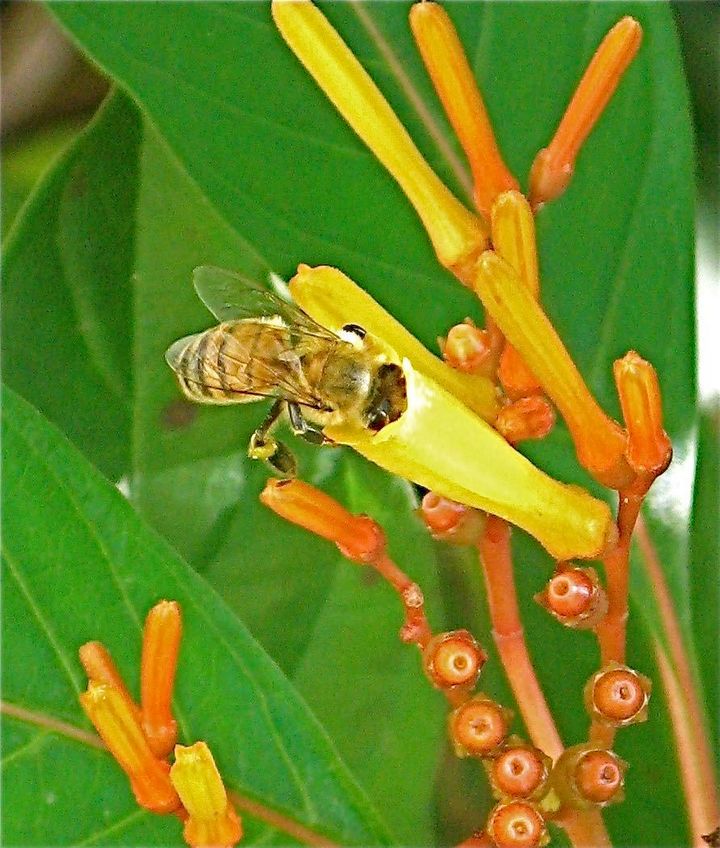Here’s to the little guys. I’m talking about bees. Maybe you missed National Pollinator Week , but you can still get in on the action. In fact, you should. Dedicating one week out of the year to protecting our pollinators isn’t enough to make a difference. I think it’s safe to say EPA DIrector Scott Pruitt isn’t looking out for the bees. Or the environment. Or us.
Without bees, we wouldn’t have honey, but bees — and butterflies — also pollinate many other delights including chocolate, coffee, raspberries, mangos, figs, blueberries, avocados, sweet summer orchard like plums and apricots, star crucifers like broccoli and cauliflower and almost every kind of nut and legume. Credit for the crops we grow — and eat— doesn’t really go to us, it goes to pollinators. Globally, pollination accounts for a whole lot of a whole food plant-based diet — a third of the food we eat. You can’t eat a plant-based diet without plants.

But the bees aren’t doing well. Since first noting the pollinator decline a quarter century ago, we’ve named the phenomenon Colony Collapse Disorder, or CCD and have seen our bee population dwindle by a third. What we haven’t done is find a cure. Researchers link CCD to GMOs, climate change, monoculture and commercial pesticides — or all of the above. The USDA has allocated $20 million over the next five years for CCD research. Meanwhile, Pruitt has reversed Obama’s ban on the pesticide chlorpyrfiros. This neurotoxin is proven to cause developmental issues in infants and is lethal to Forager bees. Thanks to Pruitt (and lobbying by chemical companies including Dow), chlorpyrfiros is back on the market and commercial growers may well use it on the very crops that require pollination.
So it’s up to us — and the pollinators — to save the world. And it’s not so hard. All we have to do is help the bees and butterflies do what they do naturally:
1) Buy organic. Many bee keepers, growers and researchers consider chemical pesticides, especially those containing chlorpyrirfos and nionicotoids (or nionics), honey bee enemy #1. Organically grown produce is chemical-free — naturally. Bees like that.
2) Buy local. When growers can sell their produce locally, they tend to farm more sustainably. Honey consumers, source your honey locally, too — you owe it to the bees. Support your local bee keeper. Chances are good they practice the traditional art of bee keeping, resulting in happy, healthy bees.
3 Leave the honey to the bees. It’s the vegan thing to do. But that doesn’t mean sacrificing sweet and sticky. Maple syrup has replaced agave nectar as fitness geeks’ fave liquid sweetener. It’s plant-based, mineral-rich, and unlike agave, low in fructose. For another sweet plant-based option, meet BeeFree Honee, honey’s bee-free twin, offering the same sweetness, slightly tart finish, golden glow and viscosity. Created by a bee keeper’s daughter, it’s organic, made with apples and without bees.
4. Turn your back yard (or balcony) into a thriving ecosystem. Avoid toxic pesticide sprays and plant native bee-attracters. Six worth planting: alfalfa, field peas, thyme, mint, rosemary and buckwheat. They’re gardener friendly and pollinator friendly, too. Happy pollinators make for a sweet, sustainable world. For all of us.

Mango Freeze
Mango and citrus, two South Florida pollinator-friendly fruits, team up with creamy coconut milk for this cool, tart, tropical treat. Not South Florida-based? Swap the mango for nectarines, peaches, plums, berries or your favorite local summer fruit. It’s a great use for summer fruit overage and requires no ice cream maker. Don’t thank me, thank the bees.
1 13.5-ounce can full fat coconut milk
1 tablespoon evaporated cane sugar
1-1/2 cups mango pulp or puree (1-2 ripe mangoes)
2 tablespoons fresh lime juice (1 good juicy lime)
4 tablespoons fresh orange juice (1 orange)
1 teaspoon rum (optional)
optional garnishes: diced mango, diced crystalized ginger, shredded coconut, mint leaves
Pour coconut milk into a small saucepan and set on high heat. Add cane sugar, stirring to dissolve. Continue stirring occasionally and let mixture come to a boil. Boil for 5-7 minutes, or until coconut milk thickens. Remove from heat and set aside to cool briefly.
Pour coconut milk into a shallow freezer-friendly container (silicone, plastic or metal), cover and freeze for about 2 hours, until coconut milk is just shy of being frozen solid.
In a blender or food processor, blitz together the mango pulp, lime juice and orange juice until smooth, about a minute. Scrape the frozen coconut milk into the food processor and optional teaspoon of rum and process again, until mixture is creamy.
Pour into freezer-friendly airtight container and freeze for least at 8 hours or overnight. Remove from freezer and let sit at room temperature for 10 minutes to soften slightly before serving.
Makes 3 cups, serving 4 to 6.
More at soulfulvegan.com.
